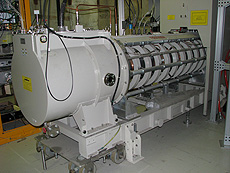Klystron six-cavity test shows promise for lower-cost linacs
 |
This high-powered klystron emits a large radio-frequency signal that can be split into several signals and managed through vector modulators for several accelerator cavities at once. Photo: Joseph Piergrossi
|
An accelerator test at Fermilab has shown that a proton beam could be accelerated with fewer radio-frequency power sources than previously used.
A cavity is one of the elements in an accelerator that helps bring a particle beam up to the desired energy. As a particle beam travels down the axis of a cavity, the changing electric fields inside help kick the beam down the line. Klystrons power the cavities, sending them radio-frequency pulses to help propel the particles.
A typical accelerator has multiple cavities, each one of which is hooked up to its own klystron. With the High-Intensity Neutrino Source accelerator at the Meson Detector Hall, one klystron drives six room-temperature cavities at once. (Despite its name, the HINS accelerator does not directly involve neutrinos. It accelerates protons.)
"The point was to see if we could find a more cost-effective way of running an accelerator," said Jim Steimel, an engineer for the project.
A klystron is one of the more expensive devices on a linear accelerator. The purpose of having one klystron per cavity is to allow fine control of each cavity's power and keep the particles accelerating at the correct rate. The HINS experiment showed that a single high-powered signal could be split among several cavities to the same effect.
"Imagine you have a barrel with six taps," said Sergei Nagaitsev, AD physicist. "Through each one you want to run water at a certain rate at a certain time. That's what this accelerator does for RF power."
Each of the "taps" on the experimental accelerator has a vector modulator, which allows an operator to regulate how much power is flowing into a particular cavity. Steimel said programming the VMs was the most difficult part of building this type of linac.
"One of the big issues was that because the VMs are high-power, they are not as fast," he said. "Bandwidth becomes an issue." A team led by Brian Chase, who leads the low-level radio-frequency group in the Accelerator Division, figured out how best to program the VMs to mitigate the bandwidth problem.
The test not only demonstrated that the single klystron could power six cavities at once, but more importantly that the vector modulators could properly distribute the power to each cavity.
This approach is best applied in linacs that accelerate pulsed beams, as contrasted with so-called continuous-wave beams. Continuous-wave linacs will still require multiple radio-frequency power sources.
Steimel anticipates that other accelerator projects will consider using this technology and is keeping the experimental setup open for others to continue research and development.
"This is a very important demonstration because of the potential cost-saving benefit to future pulsed linacs," said Associate Director for Accelerators Stuart Henderson. "Achieving this successful demonstration was the result of a lot of hard work by the HINS team."
Nagaitsev agreed.
"It was important for us to do this because others in the world were asking us how it would work," Nagaitsev said.
Physicist and Project X Project Manager Steve Holmes said he is looking at the technology for possible use in the future downstream pulsed linac section of Project X.
"It seems like such a natural approach to saving money," Holmes said.
—Joseph Piergrossi
|